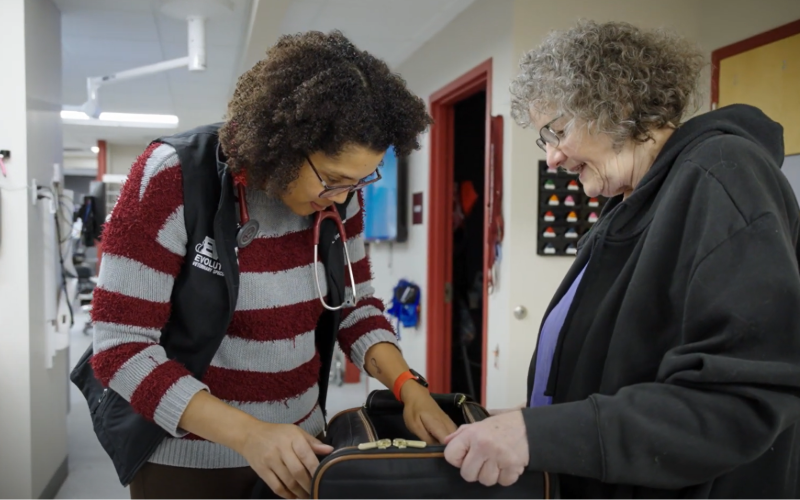What You Required to Know Regarding Veterinary Solutions: A Summary of Diagnostic Tools and Procedures
Vet services play a crucial function in preserving the health and wellness of pets. Normal exams can disclose concealed health issues beforehand. Different diagnostic tools and treatments, such as blood tests and imaging strategies, offer important insights into an animal's health. Comprehending these methods is crucial for pet owners. What details analysis treatments are most typically made use of, and how can they affect an animal's therapy strategy?
Relevance of Routine Vet Check-Ups
While lots of pet owners may take too lightly the importance of routine vet check-ups, these visits are important for preserving a pet's overall health and wellness. Regular brows through to the veterinarian enable very early discovery of potential health issues before they intensify right into significant issues. Regular check-ups commonly consist of inoculations, which are essential for preventing infectious diseases that might drastically impact a pet's health. Furthermore, these appointments provide a chance for veterinarians to evaluate the pet's weight, oral health, and total problem, making sure that the pet dog is growing. Throughout these gos to, family pet proprietors can additionally obtain useful recommendations on diet regimen, workout, and preventative treatment tailored to their certain animal's requirements.
Common Diagnostic Procedures in Veterinary Medicine
In veterinary medicine, exact diagnosis is necessary for efficient treatment. Usual analysis procedures include blood screening methods, progressed imaging innovations, and urinalysis, each playing a significant duty in determining wellness concerns. Comprehending these techniques enhances the capability to supply suitable look after pet clients.
Blood Testing Methods
Blood testing strategies act as essential analysis tools in veterinary medication, allowing veterinarians to assess the health of pets precisely. These strategies include collecting blood samples to examine various parts, such as red and white blood cells, platelets, and biochemical markers. Usual tests include full blood matters (CBC), which examine total health and wellness and detect infections, and biochemical panels, which assess body organ feature and metabolic status. Furthermore, serological examinations can determine specific illness via antibody detection. Blood screening is minimally invasive and supplies important details that helps in identifying problems, keeping an eye on wellness condition, and assessing actions to therapies. In general, these techniques play an important function in making certain perfect treatment for pets and livestock alike.
Imaging Technologies Made Use Of
Analysis imaging modern technologies are important devices in vet medicine, matching blood testing methods by giving aesthetic insights into an animal's internal structures. Common imaging techniques include X-rays, which are helpful for assessing bone cracks and spotting foreign objects, and ultrasound, which enables for real-time visualization of soft cells and body organs. Magnetic resonance imaging (MRI) supplies in-depth photos of intricate physiological locations, especially in neurological analyses. Calculated tomography (CT) gives cross-sectional photos, boosting analysis accuracy for numerous problems. Each of these modern technologies help veterinarians in diagnosing illnesses, planning treatments, and keeping an eye on healing. By integrating imaging innovations, veterinary experts can better evaluate an animal's health and make informed choices regarding their care.
Urinalysis and Diagnostics
Urinalysis offers as a crucial analysis device in vet medicine, providing useful understandings right into an animal's overall health and aiding in the detection of various problems. This non-invasive treatment evaluates urine samples to analyze kidney feature, hydration status, and metabolic problems. Usual elements taken a look at include details gravity, pH degrees, glucose, healthy proteins, and the presence of blood or microorganisms. Unusual findings can suggest issues such as urinary system tract infections, diabetes mellitus, or kidney illness. To enhance analysis accuracy, urinalysis is often executed in combination with various other examinations, such as blood work and imaging researches. Early discovery through urinalysis can cause timely treatments, improving the diagnosis for many veterinary patients. Therefore, it is a crucial aspect of thorough vet care.
Comprehending Blood Examinations and Laboratory Analysis
Comprehending blood examinations and laboratory analysis is essential in veterinary medication as it aids in detecting various health and wellness problems in animals. Different kinds of blood examinations offer important details concerning an animal's internal state, while translating laboratory results requires careful consideration of countless elements. This section will certainly explore the kinds of blood tests available and the relevance of their outcomes.
Sorts Of Blood Examinations
Blood tests play a vital duty in vet medication, providing crucial understandings into a pet's health and wellness status. Different sorts of blood tests are utilized, each offering various objectives. Complete blood matters (CBC) examine general health and wellness and find conditions such as anemia or infection. Biochemical accounts examine organ function by gauging enzymes and electrolytes, offering insights right into metabolic wellness. Serological examinations recognize details antibodies or virus, assisting in the diagnosis of infections or autoimmune illness. Blood typing guarantees secure transfusions, while coagulation examinations determine the blood's capacity to embolisms, crucial for procedures. These tests jointly boost diagnosis, treatment preparation, and surveillance of an animal's health, illustrating the relevance of extensive laboratory evaluation in vet care.

Interpreting Lab Outcomes
A comprehensive evaluation of laboratory results is crucial for accurate diagnosis and therapy in vet medication. Interpreting lab results requires an understanding of regular recommendation varieties and the value of inconsistencies. Blood tests can disclose different health and wellness indications, such as body his comment is here organ feature, electrolyte balance, and the presence of infections. Veterinarians need to take into consideration the whole medical photo, consisting of the pet's background, health examination searchings for, and any symptoms presented. Variations in results may arise from factors such as age, breed, and underlying health and wellness problems. Laboratory outcomes must not be checked out in seclusion yet rather as part of an all-encompassing analysis approach. Exact analysis enables for customized treatment strategies and much better outcomes for vet individuals.
Imaging Techniques: X-rays, Ultrasounds, and Beyond
Imaging methods are necessary tools in veterinary medicine, offering crucial insights right into the health and wellness and wellness of animals. Among one of the most frequently used techniques are X-rays and ultrasounds. X-rays are important for envisioning bone structures, helping veterinarians recognize cracks, tumors, or international objects. This technique is non-invasive and fast, making it suitable for urgent situations.Ultrasounds, on the other hand, make use of acoustic waves to develop pictures of soft cells and organs. This strategy is particularly valuable for taking a look at the heart, abdomen, and reproductive organs, permitting vets to assess problems like liquid accumulation or organ abnormalities.Beyond X-rays and ultrasounds, advanced imaging strategies such as computed tomography (CT) and magnetic resonance imaging (MRI) are significantly used in veterinary method. These approaches offer in-depth cross-sectional images, improving the precision of diagnoses and treatment strategies. Ultrasound For Dogs. Generally, imaging methods play an important role in making sure reliable vet treatment
The Duty of Biopsies in Diagnosing Animal Health Issues
Accuracy in diagnosing health and wellness problems in animals frequently rests on using biopsies, which provide definitive info regarding cells irregularities. A biopsy includes the elimination of a little example of cells for evaluation under a microscopic lense, enabling veterinarians to determine various problems, including infections, growths, and inflammatory diseases. This diagnostic tool is necessary for comparing benign and malignant growths, guiding therapy decisions, and reviewing the seriousness of a condition.Biopsies can be executed using various methods, such as needle aspiration, incisional biopsies, or excisional biopsies, relying on the location and sort of cells involved. The option of approach may influence recuperation time and the amount of cells accumulated. Ultimately, the details obtained from a biopsy can lead to targeted therapies, boosting end results for family pets dealing with severe wellness challenges. Vets highlight the significance of this procedure in accomplishing precise medical diagnoses and effective therapy strategies.
Advanced Diagnostic Equipment: Endoscopy and CT Scans

Advanced analysis tools, such as endoscopy and CT scans, play an essential duty in modern-day vet medicine, offering non-invasive techniques to imagine internal structures and detect different conditions in pets. Endoscopy entails using an adaptable tube equipped with a camera, permitting veterinarians to analyze the check out this site gastrointestinal tract and breathing system directly. This technique can disclose irregularities such as tumors, foreign bodies, or swelling, allowing targeted therapy plans.CT scans, on the various other hand, utilize advanced imaging modern technology to develop comprehensive cross-sectional photos of the body (Cancer Veterinary Near Me). This method is particularly beneficial for evaluating complicated frameworks like the mind, back, and joints. By giving high-resolution images, CT scans aid vets in identifying issues that may not be evident via traditional radiography. With each other, these advanced tools boost analysis accuracy, boost therapy outcomes, and eventually contribute to much better total pet health administration

Analyzing Examination Results: What Animal Owners Need To Know
Comprehending examination results can be a difficult job for animal proprietors, specifically after advanced procedures like endoscopy and CT scans have actually been done. Interpreting these results requires an understanding of clinical terminology and a clear understanding of what the searchings for suggest about the pet's wellness. Vets commonly supply descriptions, but the complexity of the outcomes can still result in confusion.Pet proprietors must proactively engage in conversations with their vets, asking concerns to make clear any uncertainties. It is necessary to understand abnormal versus regular outcomes and the ramifications for the pet dog's treatment plan. In addition, recognizing that some outcomes might need further screening or tracking can aid proprietors remain notified concerning their pet's health trip. Ultimately, a joint technique between pet owners and vet professionals cultivates much better wellness end results and boosts the total care experience for pet dogs.
Regularly Asked Questions
Exactly how Do I Pick the Right Vet Facility for My Pet?
Choosing the best vet facility includes investigating local alternatives, examining credentials, visiting centers, and evaluating team communications (CT Scans For Dogs). Focusing on referrals from relied on sources can aid assure the best care and atmosphere for a pet dog's health and wellness requirements
What Should I Do if My Family Pet Declines to visit the Veterinarian?
When a family pet refuses to visit the veterinarian, it's suggested to continue to be tranquil, use treats or playthings to lure Full Article them, and think about arranging a home check out if stress and anxiety persists. Persistence and positive reinforcement are crucial.
Are There Telehealth Options for Vet Solutions?
Telehealth options for veterinary services are increasingly offered, enabling family pet proprietors to talk to vets from another location. These solutions make it possible for conversations concerning health and wellness problems, advice on minor ailments, and follow-ups without needing to visit a facility.
Just how Often Should My Pet Have Dental Check-Ups?
The regularity of oral check-ups for pet dogs generally depends upon their age and breed. Typically, veterinarians recommend annual oral examinations, although some family pets might need more frequent check outs to maintain optimal dental health.

What Are the Expenses Related To Veterinary Diagnostics?
The prices associated with veterinary diagnostics can vary extensively, usually varying from basic tests like blood job to advanced imaging methods. Variables influencing costs include the facility's location, equipment utilized, and details tests needed for every pet. Veterinary services play a crucial duty in maintaining the health and wellness of family pets. While several pet proprietors may undervalue the value of regular veterinary check-ups, these appointments are necessary for keeping a pet's total health. Additionally, these consultations provide an opportunity for veterinarians to assess the animal's weight, oral health, and overall condition, ensuring that the animal is flourishing. Accuracy in detecting wellness concerns in pet dogs usually hinges on the usage of biopsies, which supply conclusive info regarding tissue abnormalities. Additionally, identifying that some outcomes might need additional screening or surveillance can assist owners stay educated regarding their family pet's health and wellness journey.